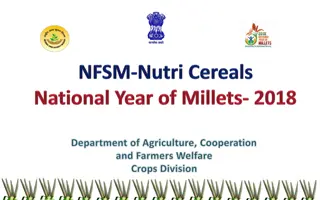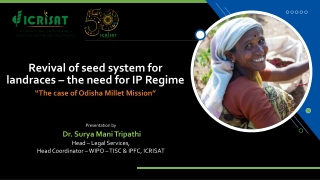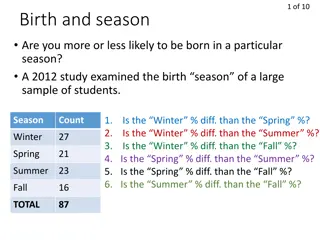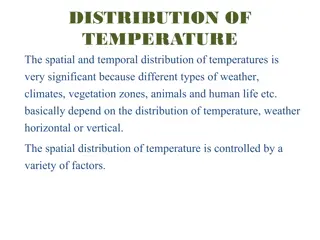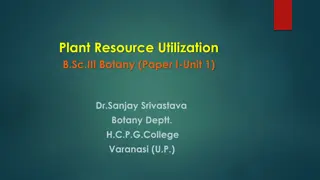Comprehensive Overview of Finger Millet (Eleusine coracana Gaertn): Uses, Importance, and Distribution
Finger millet, also known as Ragi, is a staple food crop in India, especially in hilly regions. It holds significant economic importance and is grown for both grain and forage. Rich in nutrients, it is favored for its versatility in culinary applications and its health benefits, including being suitable for diabetics and pregnant women. Originating in India, finger millet is cultivated in several countries, with India leading in production and improvement efforts.
Download Presentation

Please find below an Image/Link to download the presentation.
The content on the website is provided AS IS for your information and personal use only. It may not be sold, licensed, or shared on other websites without obtaining consent from the author. Download presentation by click this link. If you encounter any issues during the download, it is possible that the publisher has removed the file from their server.
E N D
Presentation Transcript
FINGER MILLET Scientific name: Eleusine coracana Gaertn Family: Poaceae (previously known as Gramineae) Chromosome number: 2n =36 (Diploid species) Mr. Triptesh Mondal Assistant Professor Department of Agronomy M.S.S.S.O.A., C.U.T.M.
Economic importance and uses: Mandua commonly known as Ragi also known in English as Finger millet, Bird s foot millet, African millet. In eminent vedic literature ragi is mentioned as ragika . It is an important minor millet grown in India. It is a staple food crop in many hilly regions of the country. In fact, it is the main cereal crop for monsoon season in some hilly areas. This crop is cultivated up to an altitude of 2100 m above MSL. It is predominantly grown as a dry land crop in Karnataka, Andhra Pradesh and Tamil Nadu. Finger millet contributes for about 50% of total small millet area and 65% production of total small millet of India, occupying nearly 3.2 million ha. Ragi is relished mostly by the rural population of southern India for the nutritious meal it provides.
Ragi is grown for both grain and forage. The green straw is suitable for making silage, which is sweet smelling and consumed by cattle without wastage. In northern hills, grains are eaten mostly in the form of Chapatis and halwa . In south India, grains are used in many preparations like cakes, puddings, sweets etc. Germinating grains are malted and fed to infants also. It is also good food for pregnant woman. Finger millet is good for persons suffering from diabetes. It is a nutritive food for adults of different ages. It contains about 76.32% of carbohydrates, 9.2% proteins, 1.29% fat, 2.24 minerals, 3.90% ash and 0.33% calcium. Besides vitamin A & vitamin B, phosphorus is also present in smaller quantities. The grain is nutritionally rich and the richest in calcium
Origin and distribution: According to DeCandolle (1886), finger millet probably originated in India. It might have originated from Eleusine Indica (Goose grass), a grass that occurs in many parts of North India. It is supposed to have spread form India to Abyssinia and rest of Africa. Vavilov (1951) and Mehra (1962) considers Eleusine coracana to be of African origin. It is grown in India, Africa, Malaysia, Srilanka, Japan & China. India is the leader in the area of finger millet improvement. In India, finger millet is grown over an area of 1.19 million hectares with a production of 1.98 million tonne and a yield of 1661 kg ha-1 (Sakamma et al., 2018). The major finger millet-growing states in India are Karnataka, Tamil Nadu, Andhra Pradesh, Odisha, Jharkhand, Uttar Pradesh, Himachal Pradesh, Maharashtra and Gujarat. Karnataka is the leading state with respect to finger millet area and production in India and accounts for 55.6% of the area and 60.7% of production in the country.
Botanical description: Finger millet is an erect, tufted annual, growing to 60-122 cm in height. It is C plant. Root system of mandua plant consists of a large number of slender and fibrous roots. Mandua plant tiller profusely. The stem is compressed with round nodes. The leaves are linear with distinct midrib, ligule and a fringe of hairs. The tillers bear at the end of the culm, earheads which consists of a whorl of finger like spikes generally, 2-8 in number in which spikelets are arranged closely on both sides of a slender rachis. Each spikelet contains 4-5 flowers. The spikes may take 6-8 days to complete flowering. Crop is self pollinated. Each spikelet contains 3-8 seeds which are very small in size and generally, reddish-brown in colour.
Climatic requirement: It is a crop of tropical and subtropical climate. It is a hardy crop. It is grown in areas having annual average rainfall between 50 to 100 cm. In regions of higher rainfall it can be raised on well drained soils as a transplanted crop. It can be grown under rainfed as well as irrigated conditions. Finger millet is not a season bound crop. So, it can be grown through out the year, if water is available, The main seasons are: 1. Punasa Ragi (or) Burada Chodi: Finger millet is grown in wetlands, prior to planting of rice in slushy conditions by taking advantage of monsoon rains in Srikakulam and Visakhapatnam districts. Short duration varieties (AKP-2) are preferred for this season. 25% ragi in the above mentioned districts is grown under this season (May- August).
2. Main Season (or) Pedda Panta: The main area under ragi crop during this season (August-November) accounts for 50% area of Srikakulam and Visakhapatnam. Suitable varieties are AKP -7 and Kalyani (WR 652). 3. Pyru season: Remaining 25% of area of Srikakulam and Visakhapatnam is under pyru season. (November/December February/March). As the crop is grown under assured irrigated conditions, the yields are high. The variety VZM-2 is recommended. Soil requirement: It can be grown on a wide variety of soils ranging from very poor to very fertile soils. It thrives best on well - drained loam or clay loam soils. Clayey soils, heavy black cotton soils, gravelly and stony soils with poor fertility and drainage are not suitable. It can tolerate salinity better than other cereals.
Field preparation: The first ploughing with mould board plough should be done immediately after the harvest of the previous crop. With the onset of monsoon, field should be ploughed with local plough 2-3 times and finally levelled. Seedbed for mandua should be free of weeds, friable and smooth for better seed germination and crop growth. Seed & Sowing: Method of sowing: The sowing is be done by broadcasting, drilling, sowing in shallow furrows and transplanting. 1. Broadcasting: In dry lands, sowing is done by broadcasting and seeds are covered by working with blade harrow which is generally practiced in coastal districts of Andhra Pradesh & Tamil Nadu.
2. Drilling : Finger millet is also sown by bullock drawn seed drills in shallow depths of 3-4 cm. This is generally adopted in Rayalaseema & Telangana regions of Andhra Pradesh and Karnataka. Sowing in shallow furrows: In Karnataka, seeds are mixed with cattle manure and sown in furrows drawn by 3 tyned seed drills. Furrows are covered by blade harrow. Seed requirement in this method is higher than normal recommendation. Transplanting: It is practiced under assured irrigation. 1) Ridge and furrow method, 2) Flat bed method. Seeds are raised in nurseries and after 20 days, seedlings are ready for transplanting in main field. 3. 4.
The irrigated crop of finger millet is sown in more than one season in Karnataka, Tamil Nadu and Andhra Pradesh. The rainfed early crop is sown in April or early May. Sowing should be done early in rainfed condition to avoid moisture stress at flowering stage. Kharif season main crop is sown during May or June. If the rains are not received in time, the sowing time is shifted forward to the end of August. The sowing should be done soon after the onset of monsoon under irrigated condition. In higher hills of north India, the optimum time of sowing for mandua is 1st fortnight of June. In rabi season, the irrigated crop is sown in September and October in Karnataka, Tamil Nadu and Andhra Pradesh. Mandua seeds are sown in nursery beds during May-June in the areas with adequate soil moisture. 3-4 weeks old seedlings should be transplanted in well prepared main field. Before pulling the seedlings, the nursery should be irrigated. Transplanted crop does not lodge during rains. Time of sowing:
Seed rate and Spacing: In case of line sowing, seed rate should be between 8-10 kg/ha. When the crop is raised by transplanting, 4-6 kg seed/ha is sufficient for raising nursery. Seed should be treated with Thiram @2.5 g/kg of seed before sowing. 15 cm x 15 cm for long duration varieties under drilling 15 cm x 10 cm for Short duration varieties under drilling Depth of sowing: Depth of sowing should be 3-4 cm in lines. Manures and Fertilizers: Apply about 10 t/ha well decomposed FYM or compost one month before sowing in all the cases (i.e., drilling, sowing in nursery bed, sowing in main field). For nursery: 40-40-40 kg N, P O and K O/ha For main field: 60-30-30 kg N, P O and K O/ha N is applied in 2 equal splits. Half dose of N along with full dose of P and K at the time of transplanting. The remaining half dose of N is top dressed at 30 DAS.
In case of drilling, entire amount of PO and KO and half dose of N should be applied at sowing as basal dose. The entire quantity of fertilizer should be applied 8-10 cm deep in soil at the time of sowing. The remaining dose of N is top-dressed in two equal split doses after 30 and 50 DAS. Water management: Ragi sown during Kharif, generally does not need any irrigation. Adequate moisture should be provided at the time of flowering and grain setting/pod filling stages. It can not tolerate waterlogged conditions. Hence, drainage facilities should be provided. After establishment of seedlings for a week or 10 days, irrigation should be cut off. This helps in hardening of seedlings and for vigorous and healthy growth.
Weed management: It is necessary to control weeds in the initial stages of plant growth & development. The critical crop-weed competition period is from 25 to 45 DAS. Weeding should be started with hand hoe at 25 DAS. 2-3 hoeings would be sufficient to control the weeds in problematic areas. Hand weeding gives satisfactory control of weeds. Integrated weed management: Pre emergence herbicides like metoxuran @0.75 kg a.i./ha + one hand weeding at 35 DAS gives excellent control of weeds. Harvesting and Threshing: The crop matures in about 120-135 DAS depending on the tract and the variety. Irrigated or transplanted crop produces more tillers than that grown in drylands. Earheads on main shoots matures earlier than tillers. As & when earheads are matured harvesting is done with sickles and straw is cut close to the ground later. Harvested earheads are kept on floor and covered by gunny bags or tarpaulins which brings change in colour to all the grain in earhead. It is dried & threshed by hand/stone roller/bullock.
Yield: In rainfed condition, 0.7- 0.8 t/ha grain yield; 1.1-1.8 t/ha fodder yield In irrigated condition, 3.0-3.5 t/ha grain yield; 3.5-5.0 t/ha fodder yield Varieties: Kalyani, Sarada, Godavari, Simhadri, Ratnagiri, Hamsa (for Karnataka) and CO-9 (12% protein; for Tamil Nadu) are some developed varieties.The other varieties are AKP-2 (for Andhra Pradesh), Suraj, Padmavathi (for Andhra Pradesh), VZM-1, Sapthagiri, Maruthi, Gauthami (for Andhra Pradesh), Bharathi, Champavathi etc. Some recently released finger millet varieties suitable for cultivating in south Odisha condition in rabi season are VL Mandua 352, KMR 204 and Arjuna.
Varietal characteristics of finger millet cv. Arjuna Parentage: SDFM 30 x PE 244 Average grain yield: 2.5-2.8 t/ha Other features: It can tolerate dry spells, moderately resistant to leaf blast, finger blast, brown seed Released from: OUAT, Bhubaneswar Varietal characteristics of finger millet cv. KMR 204 Parentage: GPU 26 x GE-1409 Average grain yield: 3.0-3.5 t/ha Other features: Early duration variety Released from: VC Farm, Mandya, University of Agricultural Sciences, Bengaluru Varietal characteristics of finger millet cv. VL Mandua 352 Parentage: VR 708 x VL 149 Average grain yield: 3.0-3.5 t/ha Other features: Short duration variety & also used for contingent crop planning Released from: ICAR-Vivekananda Krishi Anusandhan Sansthan, Almora, Uttarakhand
Cropping systems: Finger millet in rainfed conditions is cultivated generally as a mixed crop with sorghum, pearl millet and a variety of oil seeds and pulses. In hilly areas it is grown mixed with soybean. Under irrigated conditions, it is grown in rotation with crops like tobacco, vegetables, bengal gram, linseed, mustard etc. Some of the most prevalent cropping sequences in north India are: Finger millet - Bengal gram Finger millet - Mustard Finger millet - Tobacco Finger millet Linseed Some of the most prevalent cropping sequences in south India are: Finger millet - Groundnut Finger millet - Sugarcane Finger millet - potato maize Finger millet - potato finger millet Finger millet - rice


